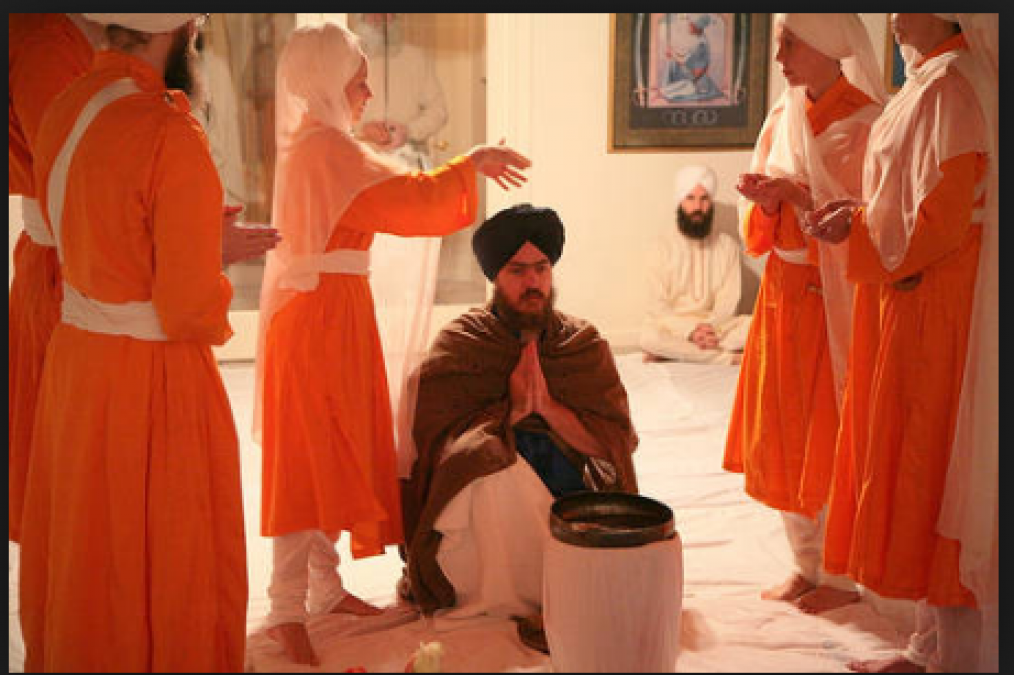
Amrit Baptism Ceremony Commencement Amrit, the Sikh ceremony of rebirth takes place in a clean and secluded location at any chosen time. To begin the Khalsa initiation ceremony, a Sikh attendant carries the Guru Granth to a low draped platform. The prayer of Ardas, is said. The attendant reads a hukam, randomly selected verse of scripture. A Sikh holds a sword and stands guard outside. At least one new initiate must participate. Initiates stand to face the Guru Granth with their hands folded. Panj pyare interview initiates seeking re-initiation, assigning appropriate penance. The panj pyare explain the Sikh tenants to new initiates, who agree to:
Worship one God.
Read the Guru Granth.
Join the Sikh congregation.
Serve others.
Refrain from worshiping any created object, or living thing.
Panj Pyare, or five beloved, are previously initiated Sikh men or women who perform the ceremony and who have:
Pleasing personalities, good health and vision, and are without physical defects.
Committed no taboo, nor broken any commandment.
Initiates are mature male, or female, of any caste, color, or creed:
Freshly bathed, freshly washed hair (covered), and clean clothing.
Adorned with kes, kanga, kachhera, kirpan, and kara.
No ornamental body piercing.
No token of any other faith.
No sort of cap, or bare headed.
Nectar of the Sword
also read After 502 years this year, Buddha Purnima occurs in auspicious Yog, Know the Pooja Vidhi
One Pyara offers a prayer for the preparation of Amrit, the baptismal water. The others stand by an iron bowl in which the Amrit is to be prepared. The attendant the guru Granth reads a hukam to the others. All the panj pyare gather around the bowl kneeling in with the left knee upright while squatting on the right heel (bir posture). One pyara pours clean water into the bowl and adds crystallized sugar.
Another pyara holds onto the bowl with the left hand, grasps a double edged iron sword with the right hand, and stirs the sugar into the water while reciting one of five Amrit banis, or ceremonial prayers. The others hold the edge of the bowl with both hands, passing the sword and reciting prayers turn by turn, concentrating fully on the Amrit nectar. When the ceremonial prayers have been completed everyone stands and one of the panj pyara offers the formal prayer of Ardas.
Administration of Amrit
Initiates, by turn, assume the bir posture, cupping right hand, over left. One pyara dips a hand into the bowl and pours Amrit into the cupped hands of an initiate saying, "Waheguru ji ka Khalsa Waheguru ji ki Fateh," (Khalsa is of the wondrous, dark dispelling light, as is victory). The initiate drinks the nectar, and answers in like manner. The process is repeated five times. One pyara sprinkles the Amrit nectar into the initiate’s eyes, saying, "Waheguru ji ka Khalsa Waheguru ji ki Fateh." The initiate answers in like manner. The process is repeated five times.
One pyara bares the top portion of the initiates head, and wets the initiate’s hair with a handful of Amrit saying, "Waheguru ji ka Khalsa Waheguru ji ki Fateh". The initiate answers in like manner. The process is repeated five times. The panj pyare each place one hand atop the head of the initiate and in one voice, reverberate "Waheguru", the Sikh name for God, thus imparting Gurmanter, or the mantra of the Guru, to the initiate who recites "Waheguru" with them.
also read Buddha Purnima 2019: Birth anniversary of Gautam Buddha; Know its significance